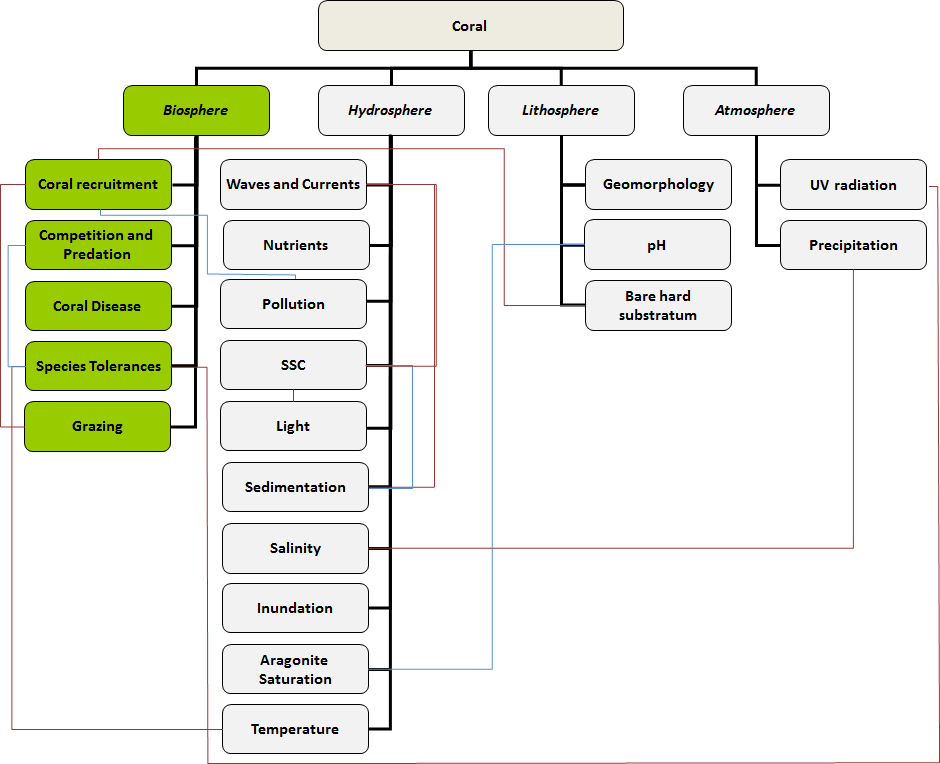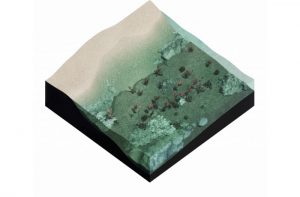Biosphere (all living organisms) – corals

Coral recruitment: Like most marine organisms, corals go through a dispersive larval phase in their life cycle. The current-induced transport of these larvae plays a major role in the spreading of natural coral communities. Coral recruitment is the process by which drifting planulae (tiny coral larvae) attach and establish themselves as members of the reef community. Recruitment is measured by the number of young individuals (e.g. coral larvae and algae propagules) entering the adult population. Recruitment can play a critical role in the formation of a new coral reef and the sustainability of the population via the number of individuals and different species that (re-)populate a reef. The importance of recruitment for community dynamics and coral populations varies by species, habitat and reef location. Population replenishment is determined by the interaction between different populations. Recruitment initially depends on successful coral reproduction based on (a.o.) fertilisation success and survival to settlement competency, which then affects the number of coral larvae. The number of new recruits actually entering a coral reef population is primarily related to five factors:
- physical oceanographic processes (e.g. transport of larvae and upwelling of nutrient-rich water),
- the abundance of larvae in the water column,
- larval behaviour (e.g. vertical migration in the water column to catch currents going in different directions),
- the availability of suitable substrata for settlement,
- the ecological factors that affect survival after settlement (e.g. competition, predation, food supply) (see reefresilience.org).
Ideally, project sites should be located in areas with a high number of recruits entering the system (connectivity) and with suitable substrata available (see substratum habitat requirement below). The recruitment rates can be monitored to ensure sufficient new individuals enter the location to form a new population.
Competition and Predation: Corals compete with a great diversity of other organisms (as well as with each other) for resources such as space and light. Interactions with other species (even other corals) can have negative effects. Macroalgae (or seaweeds) are a major competitor for space on coral reefs. In particular their rapid growth rates (linear extension rates of ~5 cm per year in corals) result in overgrowth and/or shading of corals. Other organisms, such as soft corals and sponges, also compete with corals for space, and some of these engage in chemical warfare, producing molecules that are toxic to corals. Other organisms impact corals by feeding on them. In the case of the Crown of Thorns starfish (CoTS), outbreak epidemics have been known to occur at extremely large spatial scales, causing devastation of large areas of coral reefs. On a smaller scale, the coral snail (Drupella) is known to release chemical signals during feeding that attract other individuals. This can result in extremely large numbers of snails on a single colony, often causing the death of the infested coral. Overabundance of superior competitors and predators in the area is likely to reduce the success of coral establishment.
Coral Disease: Infectious biotic diseases involve an interaction between a host, an agent, and the environment. Relatively little is known about coral diseases but some, such as black-band disease, aspergillosis, dark spots disease and plaque have been correlated with poor water quality and relatively high water temperatures and can cause severe mortality on reefs (Rützler et al. 1983; Taylor 1983; Kuta and Richardson, 2002). More information can be found on the Global Coral Disease Database.
Species tolerances: Exceedance of tolerance limits of a species to a stressor will result at minimum in a reduced health condition (sub-lethal stress), and at worst in death (lethal stress). Sub-lethal levels of stress can further reduce species’ tolerances to other kinds of impacts, such as disease. The physiological tolerance of a coral varies among colonies of different species, colonies of the same species, and with life stage. For the coral holobiont (the entire community of living organisms that make up a healthy coral head), the physiological tolerance of both partners, the coral host and the zooxanthellae, are important in their response to environmental stressors (Fitt et al. 2009). Some corals like Acanthastrea, Porites, Hydnophora, Merulina, Favia, Goniastrea, Leptoria, Montastrea, Platygyra, Cyphastrea and Galaxea are considered more resilient to light stress, although there is a trade-off resulting in slow growth rates and often thick or less integrated coral tissues. More information on resilience and susceptibility to bleaching can be found on the coral species susceptibility page on reefresilience.org.
Grazing: Grazing by reef herbivores is an important aspect of carbonate cycling and in a healthy system regulates the community structure by managing the competitive relationship between the microalgae and corals. Organisms, like parrotfish (Family Scaridae), pufferfish, surgeonfish, worms, gastropods, sponges, nudibranches, crabs, starfish, sea urchins and sea turtles, scrape off the surface of the coral as they feed on live coral. Also coralline, filamentous and endolithic algae growing on dead reef substrata are grazed so new corals can grow on top of the (bare) dead coral skeletons. Grazers of coral can also negatively affect chances of success of establishing a sustainable coral reef, when growth and grazing are out of balance. Grazing does actively remove newly settled coral larvae and is a cause of significant post-settlement mortality. Species such as the Crown-of-Thorns starfish can multiply quickly to epidemic numbers under certain conditions and can rapidly cause mass mortality of large areas of corals. Although grazing is an important aspect of the ecosystem, it is difficult to give requirements in the sense of creating a suitable habitat. Grazing cannot be measured and will differ from reef to reef, depending on overall connectivity and whether there are enough chemical “reef cues” to induce the settlement of these grazers.

